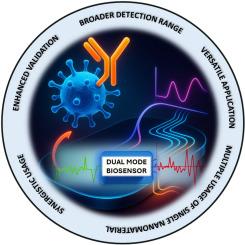Recent advancements in dual modality biosensors for detecting disease causing pathogens
IF 12
1区 化学
Q1 CHEMISTRY, ANALYTICAL
引用次数: 0
Abstract
Early detection of infectious diseases is crucial for timely therapeutic intervention. Biosensors have emerged as vital tools for analyte detection across biomedical, food safety, and clinical diagnostics. Despite their promising advancement, conventional biosensors face challenges such as signal noise and environmental variability. Additionally, issues like cross-reactivity and calibration difficulties in miniaturized devices compromise their accuracy and reliability. To address these limitations, dual modal biosensors have been developed, integrating two complementary detection techniques to enhance applicability. By cross-validating data, these biosensors can significantly reduce false positive and negative results while providing reliable measurements in complex biological matrices. Furthermore, dual modal biosensors expand the range of analytes and improve detection limits. This review explores the fundamental principles of various biosensing modalities and highlights their collaborative integration as a promising disease diagnostics approach. Translation challenges are also discussed, and future directions are proposed to bridge the gap between laboratory research and real-world applications.

用于检测致病病原体的双模态生物传感器的最新进展
传染病的早期发现对于及时的治疗干预至关重要。生物传感器已成为生物医学、食品安全和临床诊断等领域分析物检测的重要工具。尽管传统的生物传感器有很大的发展前景,但仍面临着诸如信号噪声和环境可变性等挑战。此外,小型设备中的交叉反应性和校准困难等问题会损害其准确性和可靠性。为了解决这些限制,开发了双模态生物传感器,集成了两种互补的检测技术以提高适用性。通过交叉验证数据,这些生物传感器可以显著减少假阳性和阴性结果,同时在复杂的生物基质中提供可靠的测量。此外,双峰生物传感器扩大了分析物的范围,提高了检测限。这篇综述探讨了各种生物传感模式的基本原理,并强调了它们作为一种有前途的疾病诊断方法的协同整合。本文还讨论了翻译方面的挑战,并提出了未来的发展方向,以弥合实验室研究和现实应用之间的差距。
本文章由计算机程序翻译,如有差异,请以英文原文为准。
求助全文
约1分钟内获得全文
求助全文
来源期刊

Trends in Analytical Chemistry
化学-分析化学
CiteScore
20.00
自引率
4.60%
发文量
257
审稿时长
3.4 months
期刊介绍:
TrAC publishes succinct and critical overviews of recent advancements in analytical chemistry, designed to assist analytical chemists and other users of analytical techniques. These reviews offer excellent, up-to-date, and timely coverage of various topics within analytical chemistry. Encompassing areas such as analytical instrumentation, biomedical analysis, biomolecular analysis, biosensors, chemical analysis, chemometrics, clinical chemistry, drug discovery, environmental analysis and monitoring, food analysis, forensic science, laboratory automation, materials science, metabolomics, pesticide-residue analysis, pharmaceutical analysis, proteomics, surface science, and water analysis and monitoring, these critical reviews provide comprehensive insights for practitioners in the field.
 求助内容:
求助内容: 应助结果提醒方式:
应助结果提醒方式:


